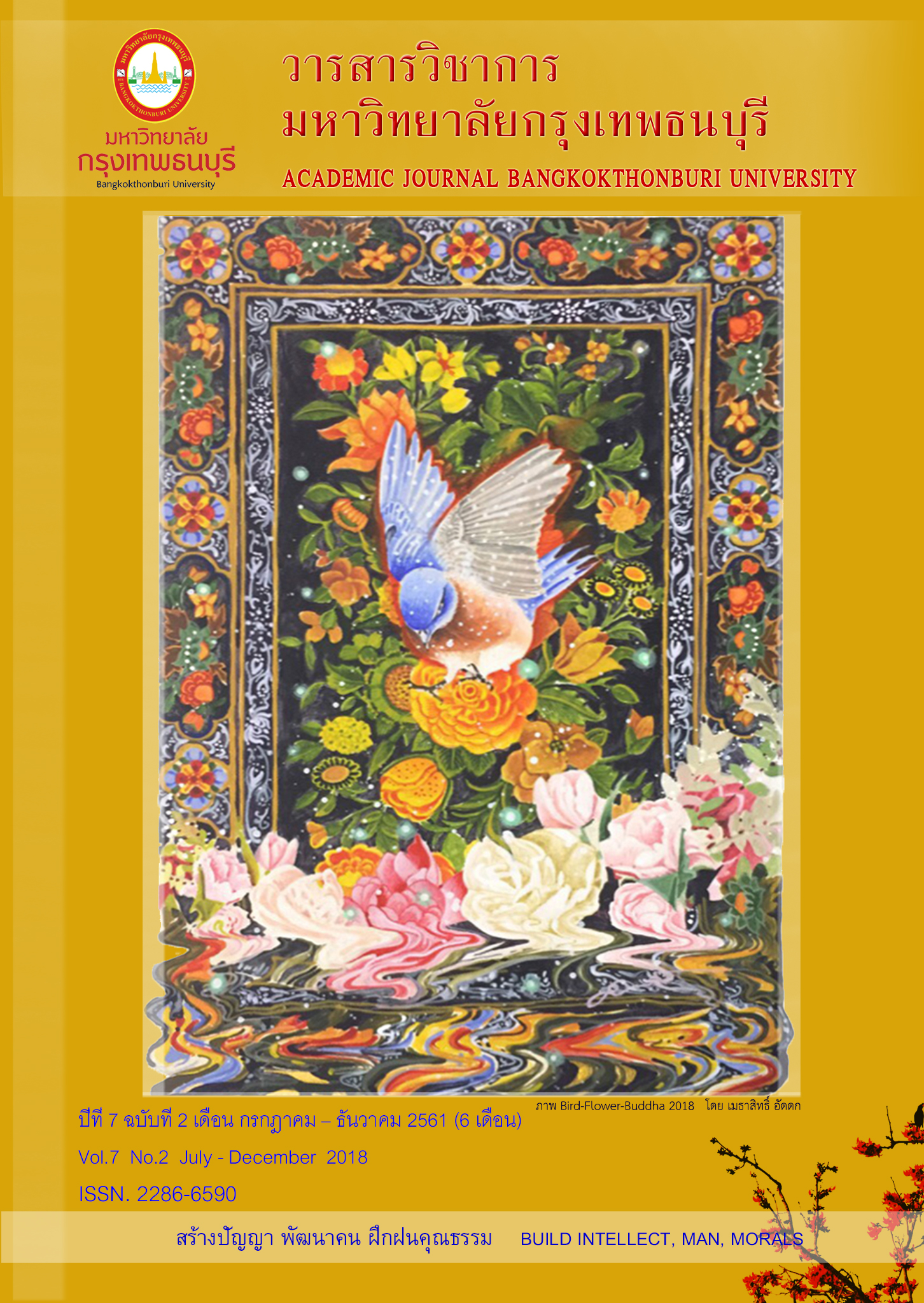The Influence of Gender and Personality Differences on Dominance Emotional Thai Words and Digitized Sounds in Young Adults: Behavioral Study Behavioral Study
Main Article Content
Abstract
The purposes of this research were to: 1) design Dominance Emotional Thai Words and Digitized Sounds Tasks in young adults 2) compare dominance emotional according to gender and personality while the participants watched Thai words and listened to Digitized Sounds on dominance emotional and 3) study interaction between gender and personality on dominance emotional Thai words and Digitized Sounds in young adults while they watched Thai words and listened to Digitized Sounds on dominance emotional. Paticipants were 80 undergraduate students, aged 20 to 24 years, Burapha University in Academic Year 2017. They were stratified into 4 groups according to personality and gender as: 20 male extrovert, 20 female extrovert, 20 male ambivert and 20 female ambivert. The research instruments were Dominance Emotional Thai Words and Digitized Sounds Tasks and Self-Assessment Mankin: SAM for Dominance dimension. Data were analyzed using descriptive statistics and Multivariate Analysis of Variance: MANOVA. The results were as follows: 1) Dominance Emotional Thai Words and Digitized Sounds Tasks consisted of 3 blocks; uncontrol, neutral and control. Each block contained 14 tasks. 2) Participants with different gender indicated significantly different in dominance emotional: uncontrol at the .05 level whereas those with different personality were not significantly different in dominance emotional at .05 level for all nature. 3) There was a significantly interaction between gender and personality on dominance emotional Thai words and Digitized Sounds at the .05 level.
Dominance emotional, Gender, Personality
Article Details
References
ธนปพน ภูสุวรรณ, เสรี ชัดแช้ม และ ศราวิน เทพสถิตย์ภรณ์. (อยู่ระหว่างการตีพิมพ์). การพัฒนาระบบคลังเสียงดิจิทัลที่สื่อความหมายทางด้านอารมณ์ ในบริบทของคนไทย. วิทยาการวิจัยและวิทยาการปัญญา, 16(1)
Aleman, A., & Swart, M. (2008). Sex differences in neural activation to facial expressions denoting contempt and disgust. PLoS ONE, 3(11), e3622. doi:10.1371/journal.pone.0003622
Bear, M. F., Connors, B. W., & Paradiso, M. A. (2016). Neuroscience: exploring the brain (4th ed.). Hong Kong: Wolters Kluwer.
Brown, L., Sherbenou, R. J. & Johnsen, S. K. (2010). Test of nonverbal intelligence (4th ed). Austin, TX: PRO-ED.
Costa, P. T. & McCrae, R. R. (2010). NEOTM Personality Inventory-3 (NEOTM PI-3).
Digman, J. M. (1990). Personality structure: Emergence of the five-factor model. Annual Review of Psychology, 41, 417-440. doi:10.1146/annurev.ps.41.020190.002221
Edmonds, W. A. & Kennedy, T. D. (2017). An applied reference guide to research designs: quantitative, qualitative, and mixed methods. California: Sage.
Eysenck, H. J., & Eysenck, M.W. (1985). Personality and individual differences: a natural science approach. New York: Plenum Press.
Filkowskia, M. M., Olsend, R. M., Dudaa, B., Wangera, T. J. & Sabatinellia, D. (2017). Sex differences in emotional perception: Meta analysis of divergent activation. NeuroImage, 147, 925–933. doi:10.1016/j.neuroimage.2016.12.016
Han, S.H., Gao, X.C., Humphreys, G.W. & Ge, J.Q. (2008). Neural processing of threat cues in social environments. Human Brain Mapping, 29(8), 945–957. doi:10.1002/hbm.20439
Kempton, M. J. et al. (2009). The effects of gender and comt val158met polymorphism on fearful facial affect recognition: an fMRI study. International Journal of Neuropsychopharmacology, 12(3), 371–381. doi:10.1017/S1461145708009395
Lotrakul, M., Sumrithe, S., & Saipanish, R. (2008). Reliability and validity of the Thai version of the PHQ-9. BMC Psychiatry, 8, 46. doi.org/10.1186/1471-244X-8-46
Lucas, R. E., & Baird, B. M. (2004). Extraversion and emotional reactivity. Journal of Personality and Social Psychology, 86(3), 473-485. doi:10.1037/0022-3514.86.3.473
Oldfield, R. C. (1971). The assessment and analysis of handedness: The Edinburgh inventory. Neuropsychologia, 9(1), 97-113. Retrieved from https://gade.psy.ku. dk/Readings/Oldfield1971.pdf
Revelle W. & Scherer R. K. (2009). Personality and Emotion. In David Sander & Klaus R. Scherer (eds.), The Oxford Companion to Emotion and the Affective Sciences. Oxford University Press 304-306. Retrieved from https://www.personality-project.org/revelle/publications/revelle.scherer.08.pdf.
Russell, J. A., & Mehrabian, A. (1977). Evidence for a three-factor theory of emotions. Journal of research in Personality, 11(3), 273-294. doi:10.1016/0092-6566(77)90037-X
Stelmack, R. M., & Stalikas, A. (1991). Galen and the humour theory of temperament. Personality and Individual Differences, 12(3), 255-263. doi:10.1016/0191-8869(91)90111-N
Vuoskoski, J. K. & Eerola, T. (2011). The role of mood and personality in the perception of emotions represented by music. Cortex, 47(9), 1099-1106. doi:10.1016/j.cortex.2011.04.011
Whittle, S., Yucel, M., Yap, B. H. M., & Allen, B. N. (2011). Sex differences in the neural correlates of emotion: Evidence from neuroimaging. Biological Psychology, 87(3), 319-333. doi:10.1016/j.biopsycho.2011.05.003
Wildgruber, D., Pihan, H., Ackermann, H., Erb, M., & Grodd, W. (2002). Dynamic brain activation during processing of emotional intonation: influence of acoustic parameters, emotional valence, and sex. Neuroimage, 15(4), 856–869. doi:10.1006/nimg.2001.0998
Wang, Y., Gu, R., Luo, Y. & Zhou, C. (2017). The interaction between state and dispositional emotions in decisionmaking: An ERP study. Biological Psychology, 123, 126–135. doi:10.1016/j.biopsycho.2016.11.009


